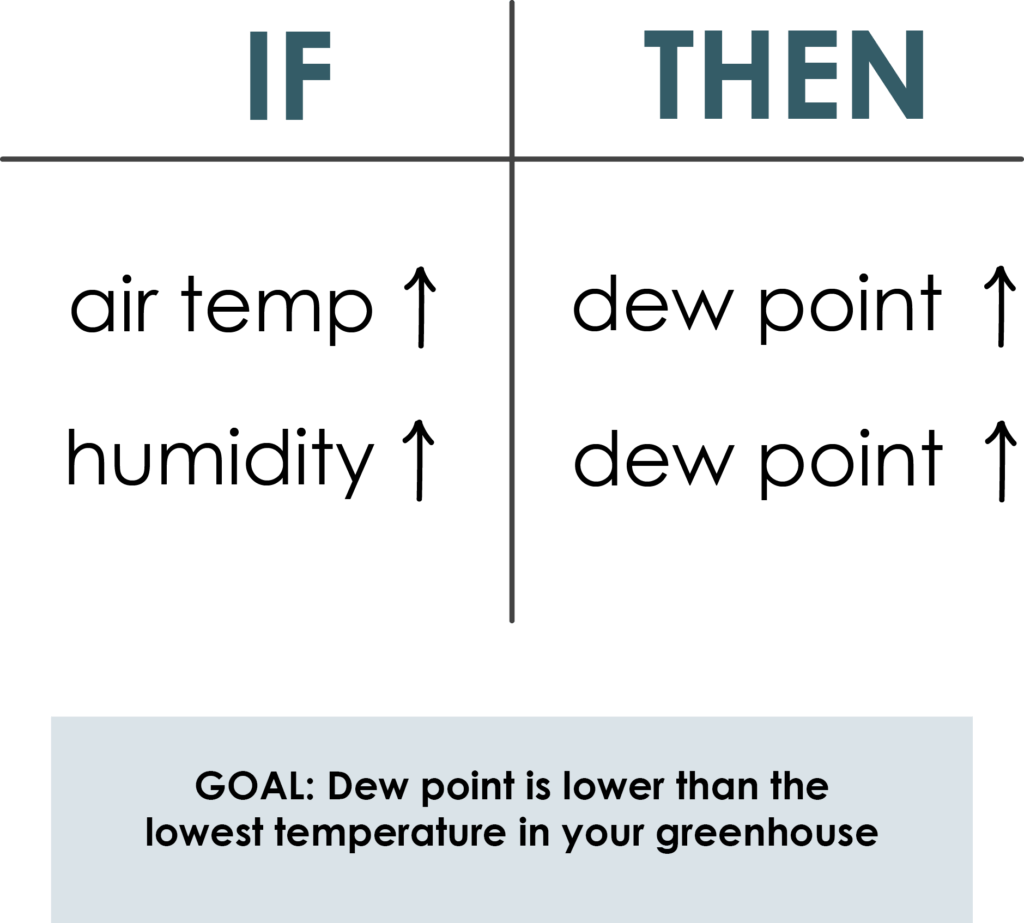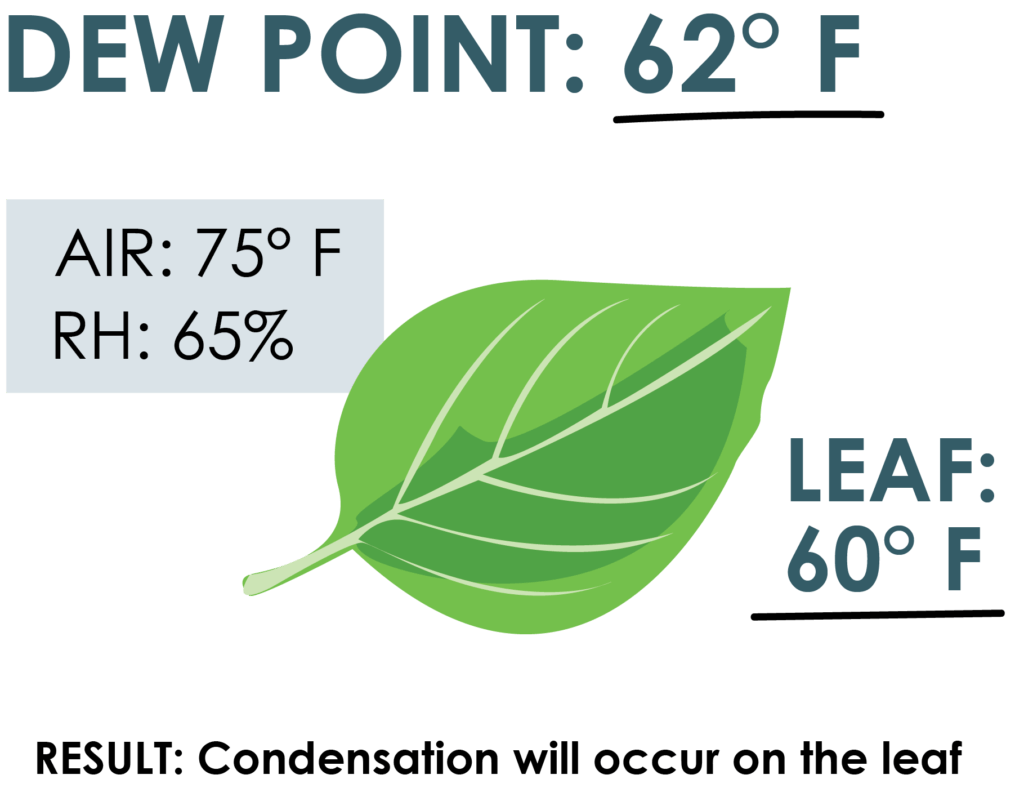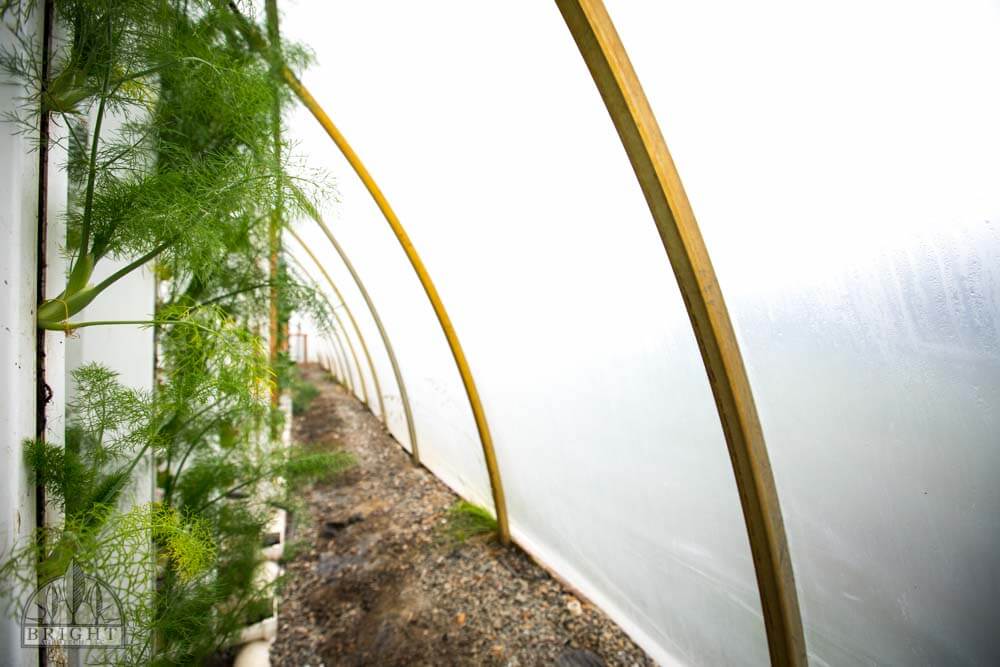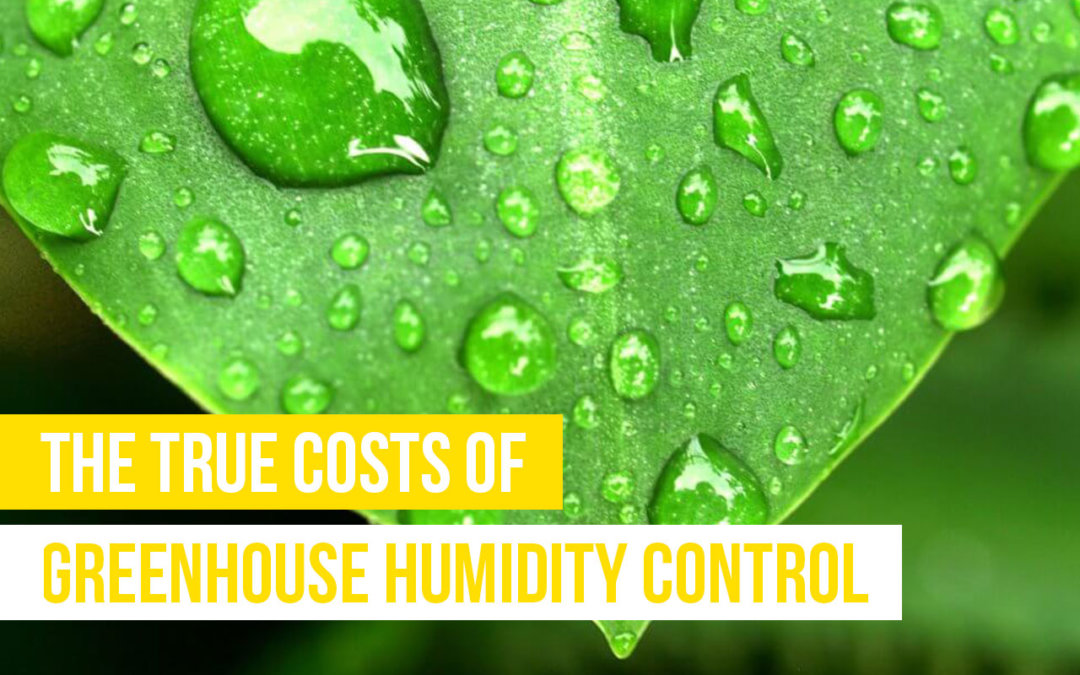Humidity can cost you in disease control & crop loss
Many growing environments have high humidity—but a goal of greenhouse managers is to keep greenhouses as dry as possible. Why? Wet surfaces and moisture encourage diseases, especially:
- downy mildew
- powdery mildew
- botrytis
Any one of these diseases and others can be responsible for significant crop loss if humidity gets out of hand.
Though greenhouse and indoor growers have been battling humidity for centuries, greenhouse humidity control can be a slippery goal to grasp due to energy-intensive methods and the relationship between humidity and heating/cooling. Luckily, new technology is changing the humidity game and removing some obstacles to efficient humidity control.
Humidity is problematic when it condenses onto surfaces (like leaves)
 The most problematic result of humidity is condensation, caused by a tricky thing called the dew point.
The most problematic result of humidity is condensation, caused by a tricky thing called the dew point.
What is the dew point?
The dew point is the temperature at which water condenses from a gas into a liquid. This temperature varies depending on humidity, air temperature, and pressure (you can calculate dew point here); the higher the relative humidity, the higher (warmer) the dew point, and the warmer the temperature of the air, the higher the dew point.
You observe the result of dew point on cool mornings when the night’s humidity has condensed on your windows or other surfaces. If you run hot water by a window or mirror, the water vapor condenses from the warmer air to the much cooler surface.
In a greenhouse, your plants provide that cooler surface for condensation. As you know by now, wet leaves are bad news for growers, since they create a perfect home for fungal diseases.
The goal is to keep dew point and the actual temperature of plants from overlapping. In greenhouses, which tend to have both warm temperatures and lots of humidity generated, dew point can be quite high.
In short:
- Dew point is when water condenses onto cool surfaces.
- Sometimes, the leaves are the first surfaces to collect dew.
- Dew means wet leaves, which means plant disease.
Let’s look at an example. In a greenhouse with a temperature of 75º F and a relative humidity of 65% (most greenhouses should be kept between 50–70%), the dew point is going to be somewhere around 62º F. Any surface reaching that temperature will collect dew.

13º different might seem like a big change in temperature, but that’s not uncommon at nighttime. Depending on the operation, this change in temperature could be hard to avoid.
Greenhouse humidity control and insulation can be counter-productive
As you can guess, lower humidity levels keep condensation at bay. In the past, humidity was effectively removed by glass greenhouse walls, which provided a cold surface for water to condense. If you’re growing in a cool climate, however, you know that glass isn’t the most effective insulator.
In places like the northern U.S., insulation is extremely important to reducing costs for year-round production. Here in Wyoming, lack of insulation combined with -30º F temperatures could wreak havoc on crops.

We have used double-layer poly film to insulate; unfortunately, insulation means warmer wall surfaces inside the greenhouse, and water vapor ends up condensing on other surfaces—namely, plant foliage!
In short:
- Glass walls are cooled by outside air and condense a lot of humidity before it becomes a problem.
- Glass walls aren’t a viable option if you need insulation.
- Insulated walls don’t get as cool, so water condenses on plant leaves.
The grower wins the battle with heating costs but pays for it in plant disease. Other humidity controls are needed.
How can we avoid condensation?
By controlling temperature and/or humid air, we might be able to lower the dew point and avoid condensation.
Let’s look at temperature. If a grower could keep surface temperatures from reaching the dew point, then they might be able to avoid condensation. The problem is that growers are already trying to keep temperatures within an ideal range for their crops. Placing another limit on that just makes the range narrower. There’s a lot of opportunity for human error here, and nighttime temperature swings and plant transpiration only make this harder.
Another approach is to replace humid air with drier outside air. But in many areas, outside air is not significantly drier than inside air. And in areas where heating is important, introducing cool air just increases heating costs. Other growers try to maintain a very excluded growing environment, and unregulated air from outside can introduce spores and insect pests. The problems with using outside air grow even more complicated, but suffice it to say that it isn’t the ideal management method.
In short:
- Theoretically, condensation might be controlled by temperature or air removal.
- Practically, controlling temperature that tightly and removing air are costly.
So avoiding dew point by changing humidity or temperature (within reason) can cause other problems. What options are left? One increasingly popular option is using a desiccant.
Desi-what? A more efficient greenhouse humidity control tool
A desiccant is a material that absorbs water from the air. A desiccant that you’re probably familiar with is silica, which is often used in packaging for materials that are vulnerable to mold in humidity. (Many cloth products, for example, come with a small silica packet included in the package.)
If desiccants could be integrated into a growing system, they could provide dehumidification without affecting heating or cooling dramatically. One new technology is the VHLC by Agam Industries, a machine that converts water vapor into water and heat which can then be reused. There’s no doubt that this type of technology could hold great potential for increasing the efficiency of growing operations.
Learn more about managing humidity in the Humidity Management: Tools & Tech course!
Learn more about farm management?
The modern farm is an exciting venture to begin since new technology is bringing new possibilities to life and information is more and more plentiful. Even with more and more videos, articles, and books coming out, though, it can be tough to know where to start and what to study to run a farm.
The courses of Upstart University are thoughtfully planned, created, and arranged for new farmers just like you. Get oriented in Upstart University then start with the Goals & Action Planning to give your farm dreams shape in the real world.
Read more: http://www.hortidaily.com/article/18574/Importance-of-humidity-control



I am new with greenhouse and recently assembled an 8 x 8 x 8 greenhouse (with help). It was suggested to keep a container of raw coal inside to help regulate humidity- is this technique something you are familiar with?
Thank you- Carol